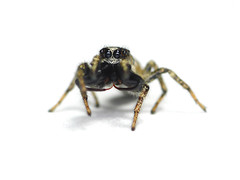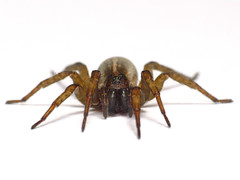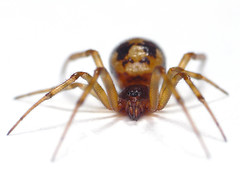Tutelina is a small genus of very interesting American salticids that deserve much more study. These spiders, which themselves seem to be generalized ant mimics, readily attack and feed upon small ants. It is generally unusual for ant mimics to attack ants, as more often the spiders are Batesian ant mimics.
This is a young male. The males have a very interesting double mohawk style hairdo that is quite something to behold. This one is just starting to grow, notice the little white tufts on the sides of his head. The females are a pretty emerald green, and I really like their flashy yellow striped legs.
Raynox DCR-150 and Raynox DCR-250
and Raynox DCR-250
 , stacked and mounted on my Panasonic Lumix FZ8.
, stacked and mounted on my Panasonic Lumix FZ8.
This is a young male. The males have a very interesting double mohawk style hairdo that is quite something to behold. This one is just starting to grow, notice the little white tufts on the sides of his head. The females are a pretty emerald green, and I really like their flashy yellow striped legs.
Raynox DCR-150




